Sustainable data centers as a service
- Traffic
- Construction
- 3/14/2022
Kraana, Möyry and Merikuokka – meet YIT’s big machines
You need heavy-duty gear to build houses, bridges and tunnels. YIT’s equipment centre ensures that all sites have access to proper machinery and equipment. Meet YIT’s big machines!
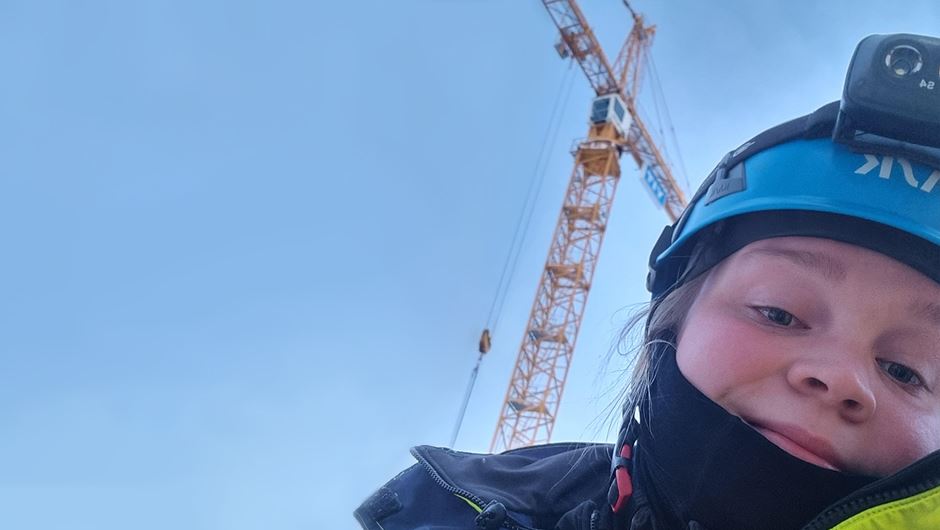
Tower crane operator Kristiina Manner sits in her cab at a height of 40 metres at the Mäkkylä construction site in Espoo. Today, she is unloading ten loads of prefabricated elements so that the construction work can continue and she can assemble the frame of the next apartment block.
The tower crane is just one of the thousands of big machines or pieces of equipment used by YIT. There are roughly 1,300 different equipment types, such as excavators or tower cranes, and as many as 200,000 different machines and pieces of equipment in total.
“The largest individual piece of equipment is the backhoe dredge, Merikuokka. The smallest one would be, for example, a form clamp,” says Kimmo Karppanen, who is responsible for YIT’s equipment operations.
YIT’s equipment services are managed by more than one hundred professionals from the Urjala and Sammonmäki equipment centres. They make life easier for construction sites by taking care of equipment planning, hiring, maintenance, servicing, transporting and installations. Every day, on average 10 full trailer combination trucks transport machinery and equipment to YIT’s sites around Finland.
For Kimmo Karppanen, who has been employed by YIT for nearly 40 years, working with big machines is a dream job.
“It’s great to be part of the development of technology and equipment and to be able to facilitate the daily life of construction sites with good machinery. Equipment is also important in terms of cutting emissions and meeting our environmental targets,” summarises Kimmo.
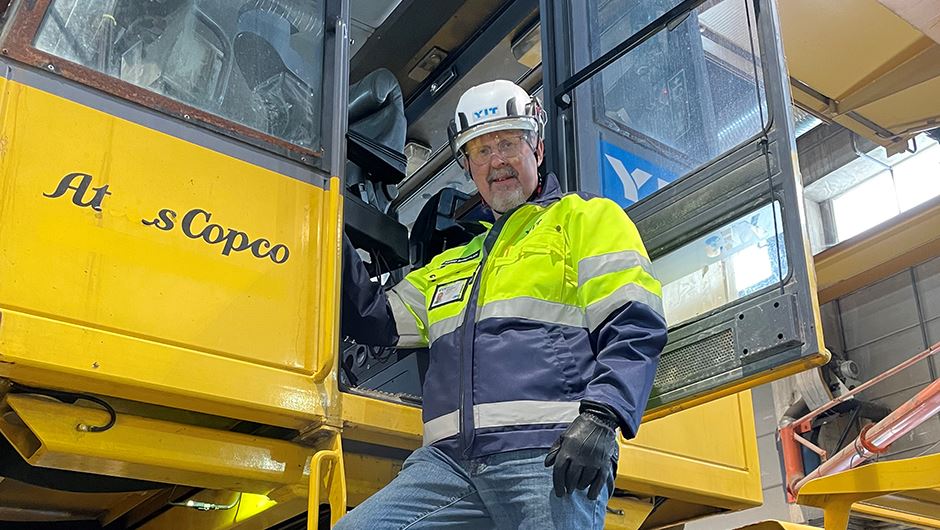
Determined to become a tower crane operator
“Oh!” is the comment Kristiina Manner most frequently hears when she tells people that she works as a tower crane operator. Kristiina was already interested in the loftiest job at the construction site when she was studying construction at the vocational school. But, back then, she wasn’t aware of what it takes to become a tower crane operator.
“When I was working at the construction site, I decided that I absolutely had to give it a go.”

In the end, Kristiina, who hails from the city of Vantaa, started her studies in Forssa to become a tower crane operator. At the controls of a tower crane, she has worked at heights as high as 100 metres. Based on her career choice, it may come as a surprise that, as a child, she suffered from a fear of heights and couldn’t even go up a climbing frame.
“The first time I climbed up a crane, I was shaking and trembling out of anxiety. But I was so determined to get up there that the fear went away.”
For Kristiina, the most interesting part about being a tower crane operator is that you can observe your handiwork from the heights – like a big girls’ Lego building.
“You feel like you are genuinely building the cityscape.”

The most challenging part of the job are the long working hours, which place a strain on the body as well as the mind. A typical workday is anywhere from 8 to 11 hours long. Most of that time, Kristiina sits up in the air in her tiny cab. Once a day, she climbs down the ladder for a lunch break. Extreme weather and strong wind also make her work harder. Controlling a tower crane, which can weigh up to 250 tonnes, takes skill, precision, quick reflexes and a keen mind.
“You have to be patient, and everyone in the work community has to understand that it is a dangerous job; if something goes wrong, the damage can be significant. For me, the most important thing is that everyone gets to go home healthy.”
Facts about YIT’s big machines
- Jumbo drilling rig
- Deep stabilisation machine
- Bored pile driving machine
- Tower crane
- Shotcrete equipment
- Construction site lift
- Machine control base station
- Backhoe dredge
Jumbo drilling rig, the giant of tunnelling work
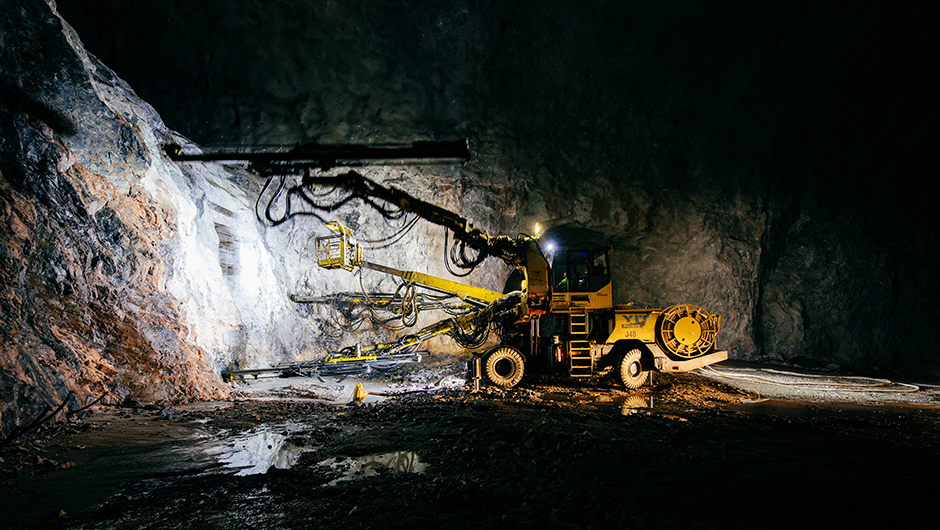
A jumbo drilling rig can weigh the same as 5–10 elephants.
Jumbo drilling rigs are used, for example, to construct metro tunnels or underground car parks and excavate other subsurface facilities. A jumbo drilling rig with two, three or even four jigs can weigh 30–60 tonnes, or the same as 5–10 elephants. The machine is roughly 15–17 m long, with a width and height of roughly 3 m each. Both the height and width of the machine increase when working.
One operator can operate a large jumbo drilling rig, but the maintenance and repair staff also play an important part. The jumbo drilling rig is equipped with good lights, enabling the operator to see when working in a dark environment. The cab is comfortable with a soft, ergonomic seat and adjustable indoor temperature and AC controls. The jumbo drilling rig also has state-of-the-art sound insulation. While hearing protectors are a must when working elsewhere in the tunnel during drilling, inside the cab of the jumbo, you can talk in normal voice without protectors.
In the cab of the jumbo drilling rig, the operator follows the drilling charts drawn up by the designer to drill 50–150 holes of different sizes into the rock in neat arc formations. The drilling speed is 5 m per minute, depending on the quality and properties of the rock. The drilled holes are of different sizes on purpose because, when the blasting starts, it progresses from the largest holes in the centre towards the periphery. The drilling and charging take hours, whereas the blasting is quickly over. After that, the same cycle is repeated.
A deep stabilisation machine works like a factory
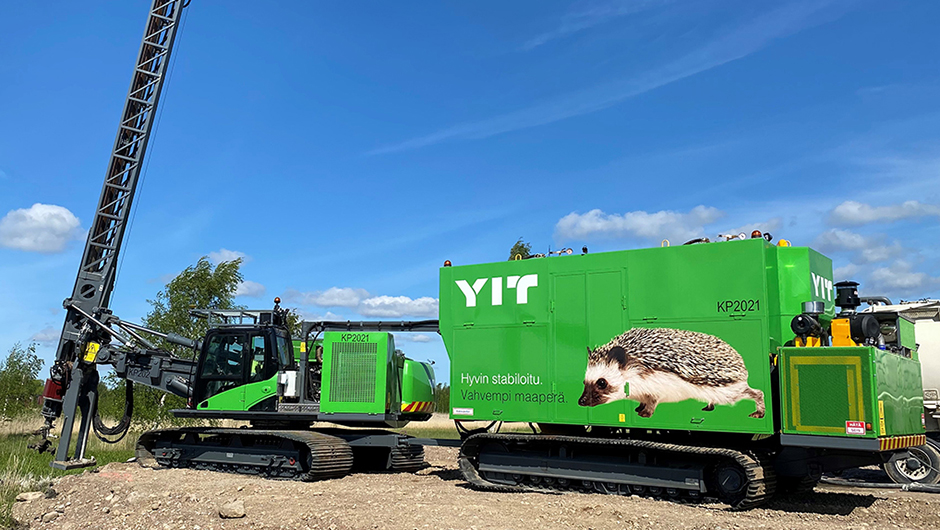
The weight of the drill carriage and the trailer approximately equals the mass of 42 large cars.
Completed in 2021, the deep stabilisation machine KP2021, more commonly known as Möyry, was designed and manufactured by YIT. A deep stabilisation machine is used to reinforce the bottom of soft land, such as a field or clay soil, so that roads, parking lots or even buildings can be built on top of it. The machine comprises two separate units, the drill carriage and the trailer. The binding agent used to stabilise the soil is transported in the container of the trailer. The machine includes two engines with a combined power of 500 horsepower. The drill carriage is approximately 7.5 m long, 3.5 m wide and 20 m high with the mast raised. The trailer is 7.5 long, 3.5 m wide and 3.8 m high. The drill carriage weighs approximately 40 tonnes. The weight of the trailer is 23 tonnes when empty and 45 tonnes when full. Combined, the weight of the drill carriage and the trailer approximately equals the mass of 42 large cars.
As a whole, the deep stabilisation machine is an incredibly complex system, which in effect works like a small factory. The blade of the machine, which resembles a drill bit or a whisk, with a diameter of roughly 0.5–1 m, is drilled into the ground, if necessary, up to a depth of 26 m. Once the blade is at the correct depth, the stabilisation work itself commences. The automatic system of the machine begins to lift and rotate the blade at the planned speed while simultaneously feeding in the binding agent, such as lime or cement, in the exact correct ratio to achieve the desired strength. The area to be reinforced may include hundreds, if not thousands, of pillars, each of which can be individually created to achieve the correct strength. As each pillar needs to be at the exact correct location, Möyry is equipped with a bespoke satellite navigation system, the accuracy of which can be further improved through YIT’s own network of base stations. This enables the locations of the pillars to be specified with approximately 2-cm precision.
It only takes one person with the necessary skills to operate the deep stabilisation machine because the complex piece of machinery is equipped with different control systems. When making pillars, the operator monitors the stabilisation process on the cab computer. When the machine is moved to the next pillar, the operator drives it using a joystick similar to a digger. When the container in the trailer is empty, the operator can disconnect the trailer from the drill carriage and drive the trailer to a filling station using a radio controller.
A bored pile driving machine is like a giant percussion drill
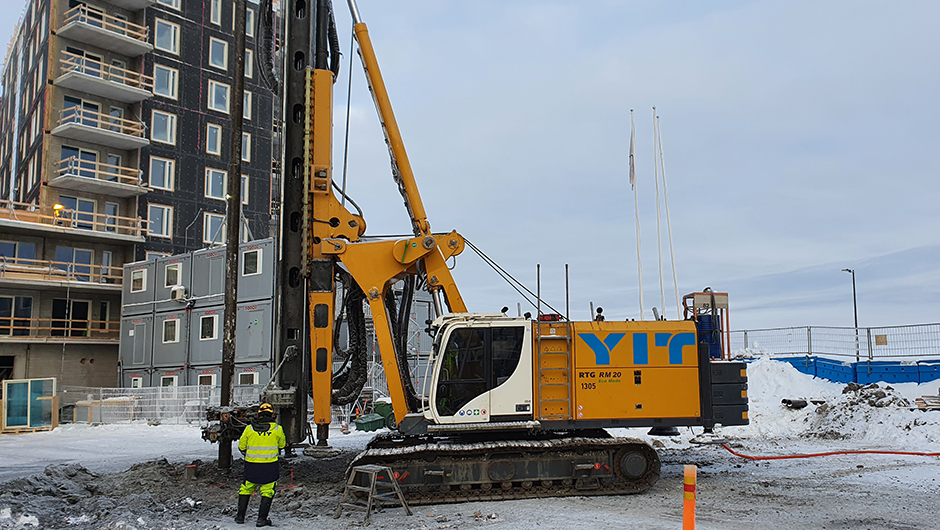
The machine weighs the same as approximately 46 medium cars.
If you hear a regular banging sound coming from a site, in all likelihood what you hear is a bored pile driving machine. It is used to manufacture steel bored piles, which are sunk into the ground so that buildings, train tracks, bridges or some other heavy, complex structures can be built on top of them. The bored pile driving machine is 8.9 m long, 2.6 m wide and 20 m high with the mast up. The machine weighs 73 tonnes – or the same as approximately 46 medium cars. The cylinder capacity of the engine is 6.7 litres.
The bored piles are typically drilled through the soft layers of earth all the way to the hard bedrock and rested against it. The mast of the machine includes a large “rotation gear”, which hydraulically rotates the steel pile in a similar fashion as a normal percussion drill. When counterboring, there is a large hydraulically operated drilling hammer at the bottom of the bored pile. At its tip, is a detachable hard-metal bit, which the hammer pummels against the rock surface with enormous force. The blades remove stone from the rock by grinding it to sand or finely crushed gravel, which is then flushed to the surface using pressurised air.
To use the hammer, the bored pile driving machine requires a separate high-pressure compressor. If the bored pile has a large diameter, up to four high-pressure compressors may be required to operate the drilling hammer. Generating high-pressure air is hard work, i.e. the compressor alone is a large piece of equipment. One high-pressure compressor may produce up to 45 m3 of air per minute at a pressure of 12–35 bar. Therefore, one high-pressure compressor may include a nearly 650-horsepower engine.
Only one person is needed to operate the bored pile driving machine itself, as the operator is able to control all functions of the machine with a remote control. On the other hand, the bored pile driving process involves several persons, such as an additional digger to lift bored piles or a welder to extend them.
A tower crane offers the best views on the site
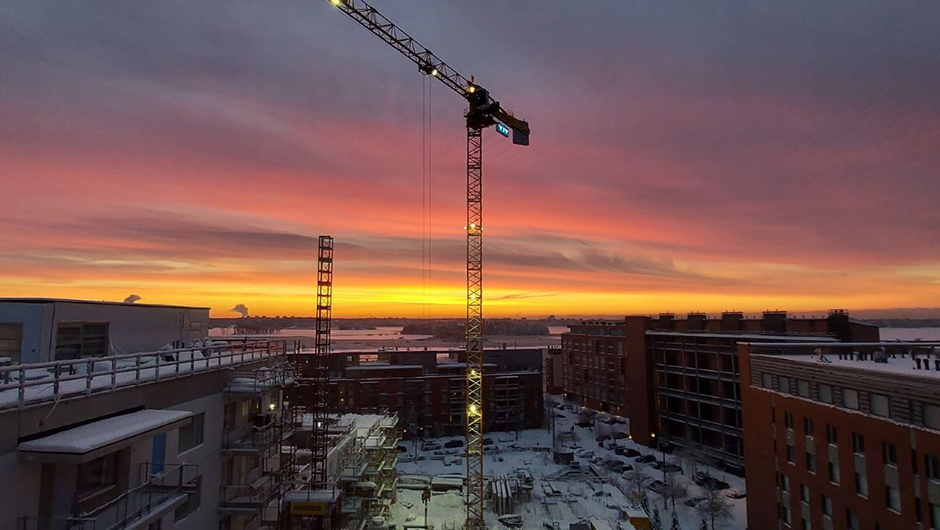
A tower crane weighs 150–250 tonnes.
“Kraana” is just one of the many nicknames of the tower crane. An electric tower crane is primarily used for assembling the frame of a building or moving and lifting goods. Typically, a tower crane weighs 150–250 tonnes. The lifting capacity varies from 12 to 40 tonnes. At its longest, the jib of a tower crane may be 80 m long. The highest free-standing tower cranes are nearly as high as the tower of the Helsinki Olympic Stadium but, supported against a building, a crane can be much higher than that.
The tower crane is operated by one person controlling the machine from the top of the crane. In new cranes, the cab is ergonomic, quiet, ventilated and warm, and it offers the best views on the site. Even though the operator enjoys good visibility from the cab, they are also assisted by a camera for trickier lifting tasks.
Erecting and dismantling a tower crane requires at least three people, a truck crane and several lorries or combination vehicles. There are many ways to set up a crane, they can be raised or lowered using a truck crane or even the tower crane itself. Tower cranes can also be moved along rails.
Shotcrete equipment makes the working conditions safe
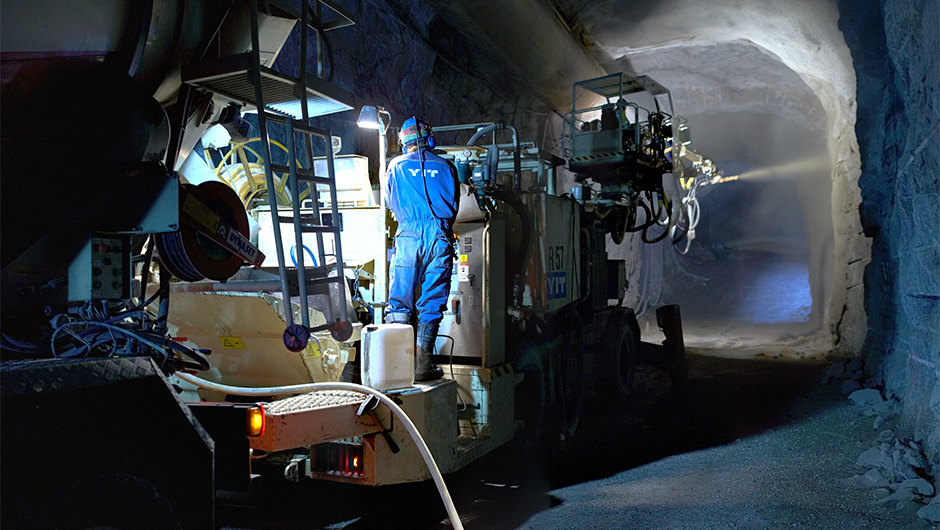
The weight of the shotcrete equipment is equivalent of 20 fully-grown elks.
Shotcreting ensures safe working conditions inside an excavated rock space because the purpose of the concrete is to prevent deformation of the rock, loose rocks from falling or water from leaking into the space inside the rock. The excavated rock face is shotcreted using shotcrete equipment – in practice, a concrete pump and hoses. The mass delivered from the concrete station is sprayed onto the rock face through a rotating nozzle nicknamed the ‘trunk’. Often, small steel or plastic fibres are mixed into the shotcrete mass to make the structure stronger. A steel mesh may be installed between the shotcrete layers for additional strength.
The shotcrete equipment is self-propelled and electro-hydraulic. It can spray tunnels up to 10 m high and 16 m wide without moving the equipment. The equipment is 13 m long, 2.5 m wide and approximately 3 m high. The weight of the shotcrete equipment is 14,500 kg, or the equivalent of 20 fully-grown elks. The equipment can be operated by one operator using remote control. The equipment includes 4WD and each of the 4 wheels can be independently controlled. The latest machines are also equipped with a state-of-the-art control system for the shotcrete process.
Passenger and freight lifts facilitating daily life at the site
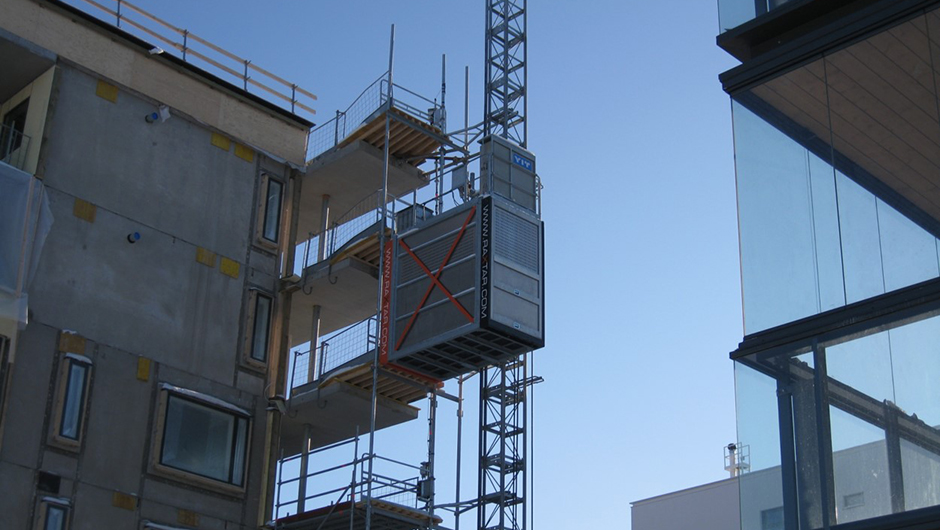
The height of a free-standing lift is up to approximately 15 m.
Lifts are used to transport personnel and materials at the construction site. Lifts make working more ergonomically viable and reduce strain because they make it easier to move from one floor to another. The speed of a site lift is from 24 m/min up to 96 m/min. The height of a free-standing lift is up to approximately 15 m, or much higher if supported. A lift weighs approximately from 5,000 kg to 10,000 kg, and it has a lifting capacity of roughly 1,000–2,000 kg or 15-–20 persons.
Site lifts follow the same principle as normal lifts inside properties. The gates on different floors are equipped with safety switches, preventing the lift from moving if the gates on the floors are not closed. Setting up and dismantling a site lift takes several persons and at least a loading crane.
Machine control base station powered by the sun
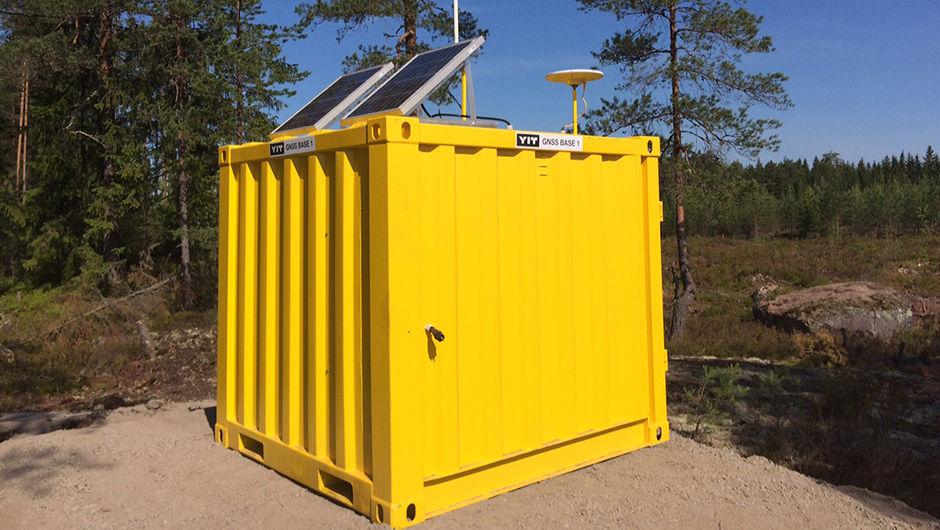
The radio signal can travel up to 30 km.
Construction is not just about machines and equipment; it also requires high technology. The machine control base station produced by YIT is used to support the operation of machine control and satellite meters to improve the measurement accuracy. Usually, the measurement accuracy when using a simple satellite receiver is from tens of metres to tens of centimetres, which is not good enough for construction use. The correction signal transmitted by the base station container can artificially improve the measurement accuracy from metres up to two centimetres, enabling the use of measuring instruments and machine controlled devices. A radio signal can travel up to 30 km. Instead of a radio modem, the base station unit can be linked to an online service, enabling the corrective data to be transmitted free of interference via the Internet.
The base station container can be powered by the mains or battery, or solely by solar power roughly from the end of April to September. The base station normally works independently without operator involvement. However, at the installation stage and in the case of a disruption, an expert measurer is required to perform measurements and install the system.
The backhoe dredge – a heavyweight of the seas
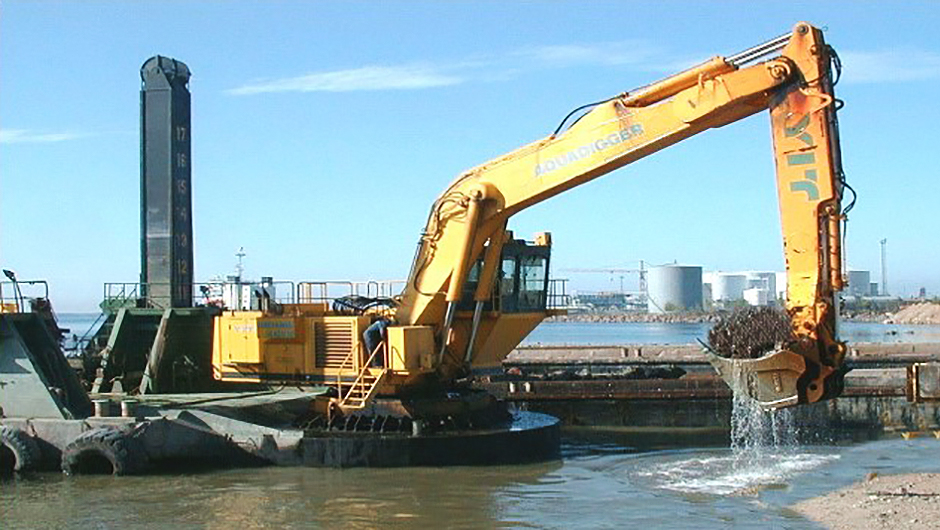
The weight of Merikuokka’s digger is a mind-blowing 130 tonnes.
The backhoe dredge Merikuokka is a real heavyweight of the seas. The backhoe dredge equipment comprises a square rig with a fixed digger. The weight of the vessel is approximately 800 tonnes, roughly the equivalent of 500 cars, and its area is roughly that of two tennis courts. The dredge is used for underwater excavation work, such as creating a shipping lane, building a port basin, removing rocks or other offshore underwater excavation or construction work.
Merikuokka’s digger is also heavy-duty. While normal diggers used at construction sites weigh 5–30 tonnes, the weight of Merikuokka’s digger is a mind-blowing 130 tonnes. Currently, its maximum dredging depth is 15.5 m. However, YIT is in the process of acquiring a new 200-tonne digger able to dredge deep lanes up to a depth of 18 m. Depending on the task, the volume of the scoop of the dredge is 4.5 m3–10 m3. In other words, you could fit a whole passenger car in the largest scoop.
While working, the dredge rests on the seabed on three supporting legs up to 18 m deep. In principle, the dredge can be operated by the operator of the vessel who controls the digger and the supporting legs from the cab. However, the rig often has a crew of 2–3 persons taking care of the other systems of the dredge, e.g. generators, positioning devices, work supervision, repair and maintenance work as well as barge organisation.
If the equipment is used in shifts, the crew may be larger and crew members may stay overnight on the rig. If necessary, Merikuokka can operate independently on the open sea for long periods of time. The rig also includes office spaces for supervisors as well as a mess hall, kitchen, showers, washing machines, toilets, changing rooms and a cabin for sleeping.

















